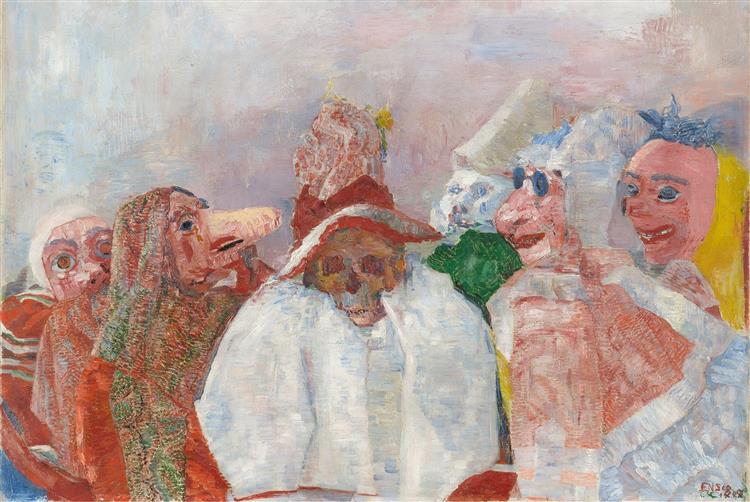Description
The work "masks mocking Death" (1888) by James Ensor is a fascinating reflection of the complex relationship of the Belgian artist with the death, life and culture of his time. This painting, emblematic of symbolism and later of expressionism, embodies the characteristic Irony, who uses the mask as a powerful symbol of identity and the perception of reality. In the central part of the composition, the skeletal figure of death is presented, recognizable by its skull and its threatening nature, surrounded by a vibrant group of masked characters that blur the boundaries between life and death, the real and the imaginary.
The choice of the mask, a recurring element in the art of design, allows a deepening in the social psychology of its time, as well as a reflection on the ephemeral of existence. The characters in the play are not mere isolated figures; Each mask carries with it a set of meanings that transcend the facial. There is a festive air on their faces, although ultimately, an underlying tension is felt as if the holiday was rooted in despair. Here, death becomes an object of mockery, a theatrical game where the characters laugh at their inevitable end.
The color palette used by design is transformative. With a bold and living use of color, intense tones create a dramatic contrast that captures the viewer's attention. The yellow, red and green ranges that predominate in the work seem almost vibrate, providing an almost cacophonic energy that reinforces the grotesque and festive nature of the scene. The light is distributed in a way that emphasizes the differences between the masked figures, which seem to be in motion, in contrast to static death in the center, suggesting that the vitality of life is ephemeral and, at the same time, laughs at its own fragility.
James Ensor, a precursor to the expressionist movement, achieves in this work an exploration of what art itself is, using its technique to question the social norms and the spectator's perceptions. The tension between horror and joy becomes a recurring theme, and the use of the mask can be understood as a comment on the superficiality of human interactions and social hypocrisy. This ambivalence maintains the power of the work, challenging the audience to reflect on its own relationship with mortality.
The dialogue about death is, without a doubt, a universal theme, and in "masks mocking death", Ensor manages to expressly express the concerns of his time, in a mixture of black humor and melancholy. This painting, along with other works such as "the entry of Christ in Brussels" and "The Carnival of the Dead", reinforces the idea of reoring as a master that he used his own experience and the Belgian culture of the late nineteenth century to create a visual language that continues to resonate in contemporary society. "Masks mocking death" is, therefore, a clear example of his ability to combine fantasy, social criticism and exploration of the human condition in a single canvas, inviting spectators to a deep reflection and, to the same Time, to a laugh that comes from the recognition of how absurd that underlies existence.
KUADROS ©, a famous paint on your wall.
Hand-made oil painting reproductions, with the quality of professional artists and the distinctive seal of KUADROS ©.
Art reproduction service with satisfaction guarantee. If you are not completely satisfied with the replica of your painting, we refund your money 100%.

